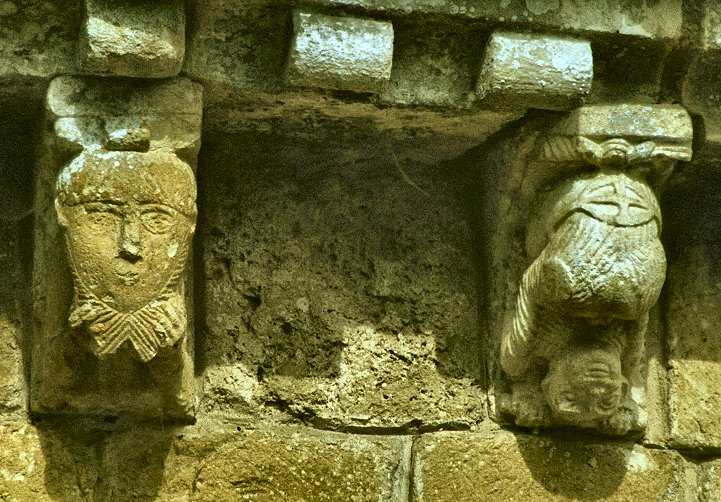MOUTH-PULLERS, BEARD-PULLERS & TONGUE-POKERS
The tongue represents calumny, blasphemy
and false witness, but is also is a stand-in for the penis,
as these New Testament lines (James III, 5-8) indicate:
"Even
so the tongue is a little member,
and boasteth great things.Behold, how great a matter a little fire kindleth.
And the tongue is a fire, a world of iniquity: so is the tongue among our
members,
and setteth on fire the course of nature; and it is set on fire of hell.
For every kind of beasts, and of birds, and of serpents, and of things in
the sea,
is tamed, and hath been tamed of mankind:
but the tongue can no man tame; it is an unruly evil, full of deadly poison..."
(verse
10) "Out of the same mouth proceedeth blessing and cursing.
My brethren, these things ought not so to be."
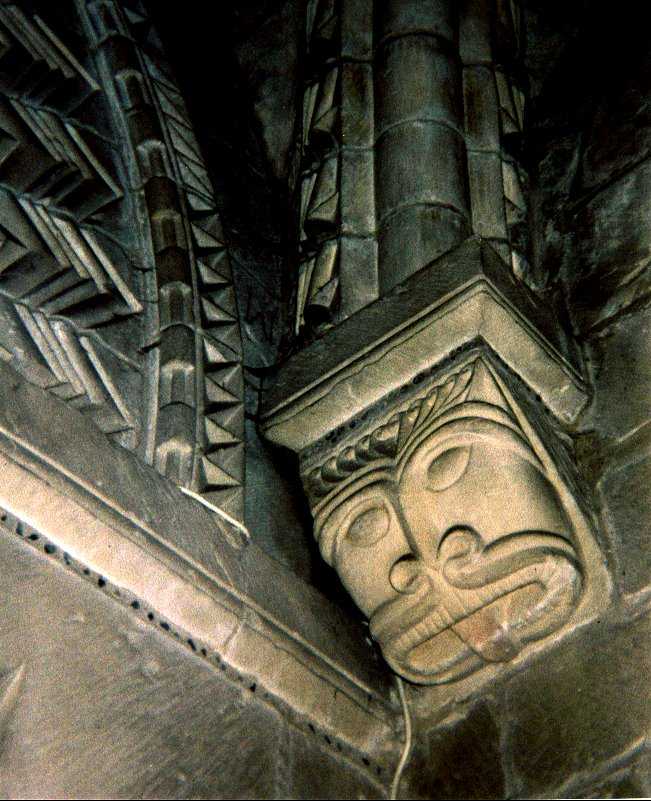
The fine Scottish Romanesque church on the best Norman style at Dalmeny
(near Queensferry, Lothian) t
has some superb carved heads on corbels and culs-de-lampe.
Mouthpullers (indicating sexual carnality) are amongst the commonest figure-motifs
in Romanesque sculpture,
and this is a very fine and well preserved, bearded example.

Compare with a beard-puller
at Cénac (Dordogne)...
...a bearded, tongue-sticking mouthpuller at Herment (Puy-de-Dôme)...

...a fine devil on a cul-de-lampe at Civray (Vienne)...

...with a pair of mouth-pulling beasts at San Antimo (Siena, Italy)...
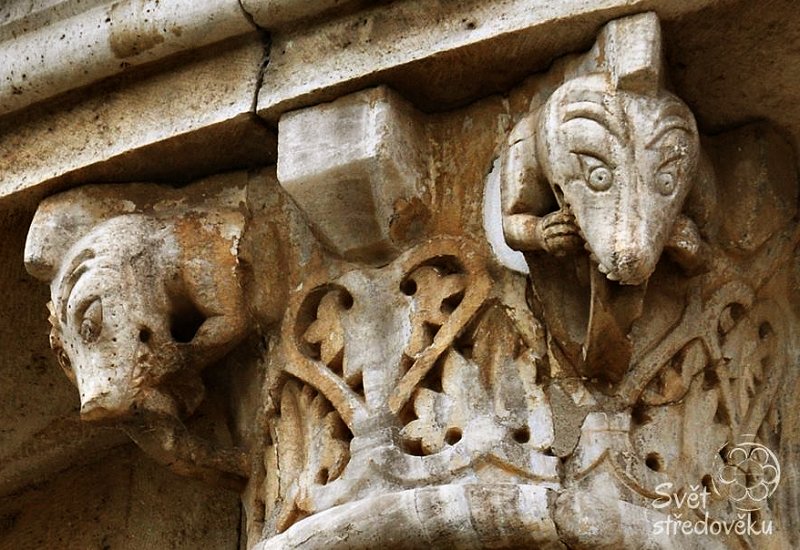
...and with this tongue-sticker -– which resembles a toothy column-swallower – at Riom-ès-Montagne (Puy-de-Dôme).

Some of the original paint is still adhering to this mouth-puller at Oloron-Sainte-Marie
(Pyrénées-Atlantiques).

click for another splendid carving at Oloron
A standing, ithyphallic mouthpuller at Vomécourt-sur-Madon (Vosges),
beside a clothed, kissing couple: onscenity and propriety.

This photograph was taken at Sacra di San Michele in Piemonte by Elio
Pallard.

Paray-le-Monial (Saône-et-Loire) : more a hider than a puller,
and popularly dubbed Le Silencieux.

Carpiquet (Calvados) : one of a number of late-Romanesque grotesque interior
corbels.

Rustic mouth-pullers are very frequent. This is a rather fetching one (retouched)
in a short-legged onesie
at Estables (Aveyron).

see other corbels at this little-known church >
A fountain outside the church of Santa Sabina in Rome - a Classical mask
-
has been adapted to imitate the 'Mask of Truth', a Roman manhole-cover at
the Church of Santa Maria in Cosmedin,
which was reputed to bite the hand off any liar who inserted his or her hand
into its mouth.
This tradition may also feed into the iconography of the mouth-puller, as
well as the tongue-sticker

Oa fine capital at Incinillas (Burgos) a tongue-poker is
about to have its eyes pecked out
by an avenging eagle (symbolising divine retribution...for blasphemy or the
bearing of false witness ?).

Compare with these remarkable tongue-poker capitals at Bouëx (Charente)...

Some tongue-stickers - like the one above at Incinillas - might be
illustrations of punishment
rather than a coded representation of lasciviousness.
But what is one to make of this female tongue-sticker in
the act of giving birth ?
A blasphemer ?

Saint-Ouen-la-Thène (Charente-Maritime)
And what about tongue-pullers like these in the Charente?
|
Pérignac |
Conzac |

And these tongue-pulling cyno- (or lyco-) morphs (with intertwining serpent-tails)
at Aulnay-de-Saintonge
(Charente-Maritime) ?

This pot-bellied, semi-acrobatic tongue-sticker at Piacenza
in Italy
might be considered apotropaic...

...as might this one at San Pantaleón de Losa (Burgos), Spain.

Only one of the four heads on the 12th century font at Greetham
(Leicestershire)
– probably representing the Four Rivers of Paradise – sticks out
its tongue.

Perhaps the king of tongue-stickers is an exhibitionist
cat-man: this amazing cul-de-lampe is in the tower
of St Wulfram's church in Grantham
(Lincolnshire) - and is post-Romanesque -
a Romanesque subject given 14th-15th century treatment by an excellent sculptor.
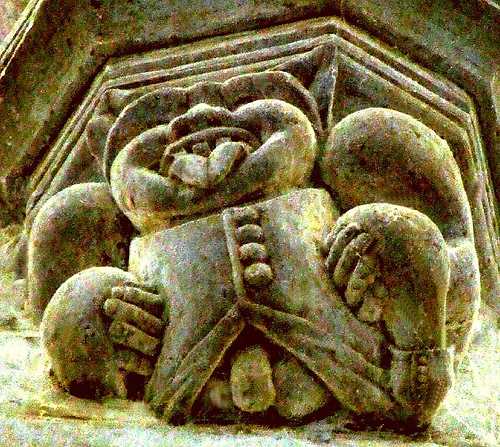
photographed by Tena Negus
Compare with a blue faience statuette of the Egyptian household god Bes,
from the second millennium BC, now in the Museo Egizio in Turin.
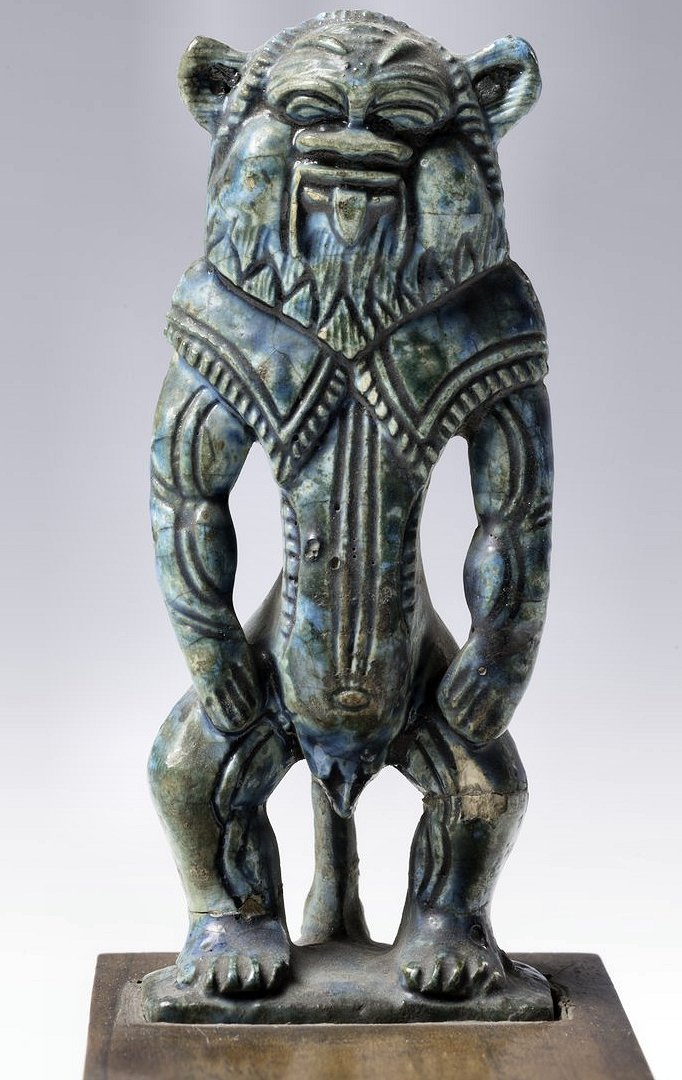
Some tongue-stickers are decorative, such as this foliate example at Cercles (Dordogne).

On Lincoln cathedral is a row of Romanesque 'beak-heads'
biting a roll,
many of whom are tongue-stickers, though one shown here displays only his
beard.

It is not surprising that demons also are portrayed as
tongue-stickers.
This one at Villeneuve d'Aveyron (Aveyron) has been imaginatively interpreted
as grabbing the scrotum
of a totally-defaced victim. Note the testicular form of his beard.

photo © Adrian
Fletcher, www.paradoxplace.com
Overlapping with Romanesque-style tongue-stickers is this 'transitional'
carving of a tongue-sticking, possibly-hermaphrodite Satan
on one of the three West Doors of Notre-Dame de Paris. Note that he is sitting
on a pope,
a wealthy cardinal, and a king.

In Norway, tongue-stickers and beard-pullers occur together as at Dalmeny.

Hedrum (Vestfold) photographed by Kjartan Hauglid

Tromøy (Aust Agder) a mis-reconstructed doorway photographed by Kjartan Hauglid.
Although the Tromøy tongue-sticker on the right looks decidedly
Eurasian, I feel that the choice of tongue-sticker as motif and symbol in
Norway
carried overtones of pre-Christian depictions of Norse Gods - possibly Lóki
(Loge), or possibly Odin who was latterly, and under the influence
of Christianity, depicted as a hanged god. The hanged are usually portrayed
with their tongues hanging out. Hanging was also reputed to cause
erection and ejaculation, and where the semen of the hanged man fell on the
earth, Mandrake grew.
Thus the motif can carry a lot of sub-meanings - including even a reference
to Judas Iscariot, who reputedly hanged himself from a tree.
It is world-wide, of course, from Borneo to Norway, via Kali in India - and
the similarity of the tongue
both to the glans penis and to the clitoris is obvious.
As for the Norwegian beard-pullers there is an obvious Scandinavian precursor
directly linked to sexuality:
Ithyphallic Norse statue of the male fertility god Freyr from Viking times.
By the end of the 12th century, however, the religious meaning(s) of these
motifs began to vanish
and they turned to the mere grotesques that merely decorate the Gothic churches
of late mediæval times.
The obviously-significant capital of the mutual beard-pullers
at Anzy-le-Duc...
(note the two men kissing on the left)

...is in contrast to an external corbel which verges on the merely-grotesque.
|
|
 Romsey Abbey (Hampshire) photographed by Kjartan Hauglid |
 Wymondham (Leicestershire) 15th century photographed by Tina Negus |
Two capitals at Sé de Viseu (Portugal)

Note the snakes.

Is the central figure holding a money-purse ?
Photos by Martin M. Miles
A fine and rare example of an arse-licking (tongue-sticking), poxy, sheep-eared,
late-mediŠval mouth-puller
on the rood-screen at Willingham (Cambridgeshire)
photographed by John E.Vigar

A roof-boss in the cloister of Norwich Cathedral.

photo by Sean Breadin
A rare tongue-sticking, mouth-pulling, Gorgon-like Luxuria on a cloister capital at Tarragona, Spain.

photograph by Peter Hubert
The Full Monty: megaphallic tongue-sticking mouthpuller at Puente la Reina
(Navarra)...

...and a much later masturbating mouthpuller at Walberswick (Suffolk).

photo by Ron Baxter
The 'Winchester Psalter' dates from the mid-12th century.
This page depicts Jesus with two beskirted demons.

From the fifteenth century, a remarkable example of a mouthpuller and a male exhibitionist in Hell,
from Rabanus Maurus, De rerum naturis, 1425,
Vatican, Biblioteca Apostolica Vaticana, Pal. lat. 291, detail of f.
67v.

Pre-Romanesque adossed tongue-sticking beasts
on the façade of the Panagia Gorgoepikoos, Athens.

The apogee of the tongue-poking motif, at Belleville-sur-Saône
(Rhône),
suggests a dramatic penitence for blasphemy and/or calumny.
See the Epistle to James, chapter III, verses 8-10 on the taming of the tongue.

High up on the corner of St Faith's church at Overbury (Worcestershire)
is a post-Romanesque grotesque (with teeth) pulling the toothy mouth of a
Blemya-like mask on her belly -
which could also be a vagina dentata...

photo by Tina Negus
Click for beard-pullers on several Romanesque capitals >
A superb Herefordshire mouth-puller in the Victoria and Albert Museum, London >
Other (Continental) Romanesque mouth-pullers >
a mouthpuller capital from  Drakestown, county Meath
Drakestown, county Meath
click for mouthpullers on Irish tower-houses >
Another (Continental) Romanesque beard >
and Irish beard-pullers/tongue-pokers >
 Marmoutier
(Bas-Rhin)
Marmoutier
(Bas-Rhin) 
Click for more superb sculptures on the façade.

A tongue-poking 'Green Man' at Nether Heyford (Northants)
photographed by Maddy
Aldis-Evans
updated June 2025
